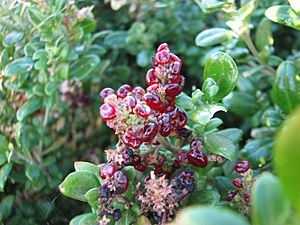Chenopodium candolleanum facts for kids
Quick facts for kids Chenopodium candolleanum |
|
|---|---|
 |
|
| Chenopodium candolleanum at Cape Woolamai, Victoria | |
| Scientific classification | |
| Genus: |
Chenopodium
|
| Species: |
candolleanum
|
| Synonyms | |
|
|
The Seaberry Saltbush (Chenopodium candolleanum), also known as Rhagodia candolleana, is a cool shrub that grows in Australia. It's part of a plant group called the Amaranthaceae family. This plant is often found in coastal areas.
Contents
What Does It Look Like?
This plant is a thick, bushy shrub. It can grow up to 2 meters (about 6.5 feet) tall.
Leaves
Its leaves are shiny green and feel thick. They are almost like tiny succulents! The underside of the leaves is a bit paler. Each leaf is usually 1 to 3 centimeters long. They are about 4 to 12 millimeters wide. The widest part of the leaf is usually near its base.
Flowers and Fruits
The flowers of the Seaberry Saltbush are small and pale. They grow in clusters called panicles. You can usually see these flowers between December and April. This is early summer to mid-autumn in Australia. After the flowers, the plant grows flat, dark-red fruits. These fruits can be up to 4 millimeters wide.
How Is It Named?
Scientists give plants special names. This helps everyone know exactly which plant they are talking about. This plant was first described in 1840. A scientist named Alfred Moquin-Tandon gave it its first formal name.
Later, after more research, scientists decided to move this plant into the Chenopodium group. This happened in 2012. Sometimes, people used to confuse it with another plant called Rhagodia baccata.
Different Types of Seaberry Saltbush
There are two main types, or subspecies, of the Seaberry Saltbush:
- Chenopodium candolleanum subsp. argenteum - This type has a silvery look.
- Chenopodium candolleanum subsp. candolleanum - This is the more common type.
Where Does It Grow?
The Seaberry Saltbush grows in several parts of Australia. You can find it in Western Australia, South Australia, Victoria, and New South Wales.
Coastal vs. Inland
The common type, Chenopodium candolleanum subsp. candolleanum, loves the coast. It often grows on cliffs and sand dunes. It can even climb among other shrubs. The silvery type, Chenopodium candolleanum subsp. argenteum, prefers different places. It grows near salt lakes that are further inland.
What Is It Used For?
The leaves of the Seaberry Saltbush can be cooked and eaten. Aboriginal people have also eaten the berries from this plant. The berries can be a bit bitter, but they were still a food source.

